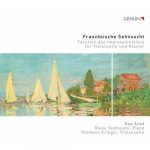

Composer: Roger Boutry, Claude Achille Debussy, Henri Dutilleux, Gabriel Urbain Fauré, Reynaldo Hahn, Charles Koechlin, Maurice Ravel, Charles Camille Saint-Saëns
Performer: Sophie Dervaux, Selim Mazari
Format: FLAC (tracks)
Label: Berlin Classics
Catalogue: 0301708BC
Release: 2021
Size: 869 MB
Recovery: +3%
Scan: cover
Saint-Saëns: Bassoon Sonata in G major, Op. 168
01. I. Allegretto moderato
02. II. Allegro scherzando
03. III. Molto adagio
04. III. Allegro moderato
05. Hahn: À Chloris (Arr. C. Colombo for bassoon and piano)
06. Ravel: Piece en forme de habanera (Arr. S. Dervaux for bassoon and piano)
Fauré: 3 Songs, Op. 7 (Arr. S. Dervaux for bassoon and piano)
07. No. 1, Après un rêve
Debussy: Suite Bergamasque (Arr. S. Dervaux for bassoon and piano)
08. III. Clair de lune
09. Debussy: Beau soir (Arr. S. Dervaux for bassoon and piano)
Koechlin: Bassoon Sonata, Op. 71
10. I. Andante moderato
11. II. Nocturne
12. III. Final
13. Dutilleux: Sarabande et Cortège
14. Boutry: Interferénces I for bassoon & piano
“A lot of people think of the bassoon as an amusing instrument. But it can be more than just the jolly clown. I wanted to show that it can sound wonderful and sing wonderfully too.”
There is no doubt that Dervaux has proved her point on Impressions. Her repertoire brings together familiar and seldom heard pieces, and at times ushers its audience into a dream world. Among those pieces are Debussy’s Clair de Lune and Beau Soir, illustrating the tonal compass of the bassoon. Sophie Dervaux also presents the Sonata for bassoon and piano in G major, op. 168, written by Camille Saint-Saëns, in his old age.
Great phrases and lines flow from Dervaux’s instrument in Fauré’s Après un rêve, and a piece she arranged herself, Pièce en forme d’habanera by Ravel, brings out the almost human voice of the instrument.
These Impressionists are joined by theorist and composer Charles Koechlin with his Sonata, op.71. Going a step further, Reynaldo Hahn’s A Cloris and Roger Boutry’s Interferénces bridge the gap between old and new and introduce jazz influences.
With her new album Impressions, Sophie Dervaux aims to show her audience what is special about the bassoon: its sound, and its virtuosity too.“This instrument means a lot to me,” she says. “It’s my voice. When I make music, I can communicate through it. I’m not a beautiful singer, but with my instrument, I can be. Singing really is the word for it: that’s what I try to do with my playing.”
French bassoon or German bassoon (fagott): this was long a difficult choice to make, so different are the two instruments. They are distinct as much for their wood (Rio rosewood in France or varnished maple in Germany) as for their technique and their sound. The timbre of the French bassoon (let us remember the beginning of Stravinsky’s Rite of Spring) is clearer and more precise than the German bassoon, which blends better with the orchestral mass. The conflict has now subsided and the German bassoon is the dominant instrument throughout the world, even in most French orchestras.
This universality of the fagott is illustrated by this recital by the French bassoonist Sophie Dervaux, first soloist of the Vienna Philharmonic Orchestra, using the German bassoon. With her compatriot Sélim Mazari at the piano, she offers a programme in which two original works, the Sonatas for bassoon and piano by Saint-Saëns and Koechlin, alternate with transcriptions of pieces by Reynaldo Hahn, Debussy, Ravel, Dutilleux and Roger Boutry.
A golden opportunity to discover an endearing instrument, whose tessitura, similar to that of a cello, can move and seduce just as much as a cello itself. Seen here, the bassoon is a far cry from the humourous or sarcastic connotations which have limited it for so long.



